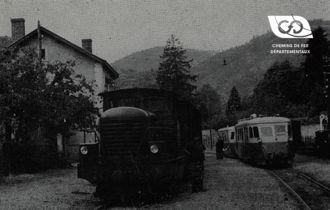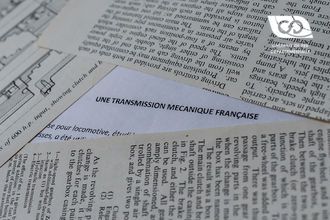In spite of their equal efficiency, hydraulic transmissions are increasingly gaining an advantage over electric transmissions because they are lighter and have a lower cost price.
Manufacturers of high-power diesel locomotives generally use either electric or hydraulic transmissions as transmissions between the engine and the axles of the machine. These two transmission systems are generally satisfactory, but their average efficiency is at most 80%, and for powerful machines the loss due to this efficiency is costly, as it can reach several hundred horsepower.
The composition of hydraulic transmissions
They consist of a hydraulic part made up of couplers and torque transformers arranged in certain arrangements, and a mechanical part generally made up of :
- of a speed multiplier at the head of the hydraulic stage,
- a mechanical gearbox with several speed ranges at the output of this stage,
- of a power shuttle,
- of axle attacks.
Because of the importance of the mechanical part, they are all " hydro-mechanical "".
The low efficiency is not due to the excellent efficiency of the gears or even the high efficiency couplings (97/98%) but to the poor efficiency (average 75-80%) of the hydraulic torque transformers.
A hydro-mechanical transmission that solves the problem of using torque transformers
It would be sufficient to create a "hydro-mechanical" transmission eliminating the use of torque transformers and using only one or more couplers.
This problem has been solved by the hydro-mechanical "Asynchro" transmission.
A single hydraulic coupler ensures all starts. No friction parts are involved in starting. Only the slipping of this hydraulic coupling ensures progressive starting. Once the convoy has been started, no sliding parts are required. All that is required for all convoy speeds is to keep the engine at a good operating speed, which is achieved by changing the gear ratio of the transmission gears.
A hydraulic transmission can therefore be achieved with a single hydraulic coupler, if it can be supplemented with a gearbox with a suitable scale.
A high-capacity gearbox that would complement the hydraulic transmission
The problem is therefore only to build a high capacity gearbox that is simple, solid and in which the gears can be changed quickly.
The use of "synchronised" gearboxes or gearboxes with gears always engaged has proved satisfactory on low and medium power transmissions.
But when it comes to increasing their capacity, the calculation shows that synchronizers quickly reach prohibitive dimensions.
Gearbox testing
Tests carried out over several years have shown that it is possible to change gear combinations quickly and easily by stopping all the rotating parts of a gearbox and by correctly interlocking the various gear trains when stationary.
There is not much difference in work between the complete stop of gears rotating for example at 1500 rpm that one wants after stopping and restarting at 1000 rpm, and the direct passage from 1500 rpm to 1000 rpm by synchronizer:
- in the first case, the work of the brake is proportional to 152, i.e. 225 ;
- in the second case, the synchronizer absorbs a work proportional to (152 ? 102), i.e. 125.
In the first case, the brake absorbs barely twice the work of a synchronizer, but this brake, external to the gearbox, can be properly dimensioned.
It has, in terms of cost price, the advantage of being unique, whereas in the second case, a synchronizer must be housed in the gearbox for each gear ratio, which alterates the dimensions of the gearbox in a sensitive way. On the other hand, the operation of the synchronisers in oil is uneven according to its viscosity, and therefore its temperature.
From a constructional point of view, the housing of the synchronizers often leads to an increase in the diameter of the pinions, even if it means reducing the width of the teeth. In the case of the external brake, on the other hand, it is possible to reduce the diameter of the pinions by increasing the width of the teeth, which, for the same transmitted power, reduces the inertia and therefore the kinetic energy, in the ratio of the cubes of the diameters.
The calculation then shows that to stop such a gearbox and restart it, the energy expenditure is very low and corresponds to only a tiny fraction of the power of the engine to which it is attached.
As a result, the braking device required to stop a gearbox is quite reasonable in size.
Brake linings commonly used in industry are perfectly suited for this type of work because the braking time is short (1 second), the average temperature of the linings remains low, which ensures good operating conditions and extremely low wear.
In other words, an 800 hp hydraulic transmission running on a torque transformer loses power by 150 to 200 hp.
A hydraulic transmission, of equal power, operating on a hydraulic coupler, loses only 30 hp, even if the gears are changed frequently.
The Asynchro transmission
With an "Asynchro" transmission, the engine cannot be continuously demanded to run at full power. In spite of this, useful work is gained.
Since the Asynchro transmission cannot use the maximum power of the engine at all times, it can be adjusted to its single hourly power (i.e. in +10%) without tiring it more than by using it continuously at its maximum continuous rpm power. In this way, a higher real gain in work is obtained.
In practice, extended tests indicate that at equal machine work, there is a fuel saving of the order of 20% which implies less engine wear.
It is obvious that in order to be able to stop the gearbox without affecting the running of the train, a freewheel is necessary, but it should be noted that it would be indispensable in any case.
Indeed, it is impossible to conceive of a hydro-mechanical, i.e. positive, transmission without a free wheel protecting the engine from the overspeeds that could be imposed by the living force of the convoy.
With regard to gear shifting, the numerous services carried out on lines with a very varied profile have shown that in single-engine vehicles, up to 800 hp, the momentary interruption of traction effort did not present any disadvantage if the duration of this interruption was short.
For high powers - the use of twin engines being advantageous - it is sufficient to shift the gears on each engine unit by 3 or 4 seconds. In this way, continuous traction is achieved without any inconvenience, because thanks to the free wheels, the two motors can run at different speeds without fear of one of them overspeeding.
It is with these considerations in mind that the "Asynchro" transmissions were developed.
source : Article "Hydro-mechanical transmissions for railcars and high-power diesel locomotives" by Pierre ZENS, engineer.





